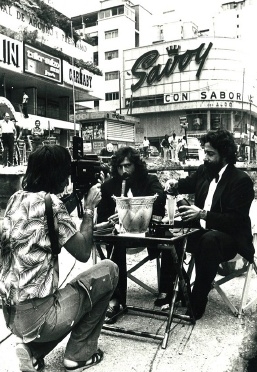Experimental film is often intimately connected with a variety of
countercultural movements, some global in reach, others very specifically
local. Some of these filmmakers explicitly embrace these movements’ radical
political goals, and at other times their ideological concerns are simply implicit, but all of these films are unified by their allegiance to a range of underground, youth or countercultural phenomena. Several of these films document performances, ephemeral actions, or interventions into public space. Marabunta, for example, a 1967 film and performance directed by Narcisa Hirsch, with the collaboration of Marie Louise Alemann, and Walther Mejía, involves the interaction of an audience-- coming out of a theater where they had seen the Buenos Aires premiere of Antonioni's Blow Up-- with fruit, live pigeons, and a giant plaster skeleton, documented in 16mm by radical filmmaker Raymundo Gleyzer. Enrique Pineda Barnet’s extraordinary Juventud rebeldía revolución offers documentation of a
performance by an international collective lead by Cuba’s Grupo de Teatro Experimental. In the spirit of Situationist détournement and punk pranks, Manuel Delanda’s Ismism** captures the filmmaker’s own interventions on Manhattan billboards, rendered across the city with an X-Acto knife.
In Esplendor do Martírio, Sérgio Péo rehearses his theory of Super 8 as a vehicle of language - which would later be materialized in his poem/manifesto "Super 8 as an Instrument of Language" Esplendor do Martírio visualizes a group of intellectuals occupying and disrupting the urban space, later to be removed by the Brazilian military. Rolando Peña, iconic figure of Venezuela’s avant-garde, produces an impossible dialogue that takes place within the noisy scene of a construction site of the Caracas Metro, echoing the complex relationship between intellectual debates and the noise of "progress." Alfredo Gurrola’s super-8 trip, based on a poem by exiled Spanish writer Tomás Segovia, points to some of the preoccupations of a counterhegemonic radical alternative culture.
In Person: Curator Luisa Marisy, director and performance artist
Rolando Peña
“The screenwriter of the landmark Soy Cuba (1964), and the director of
eight features and a number of shorts, Enrique Pineda Barnet is more than
an eminent film director who also writes prose and poetry: he is someone
who day after day thinks of himself as a beginner in every activity he
undertakes.” – lahabana.com
"Marabunta is also notable for bringing into proximity with the cinema a crucial element of her performance-based work, namely its attempts at converting a random assortment of strangers into a group of participants and spectators, at once observing and being observed, affecting the work and being affected by its arena of activity." –Federico Windhausen
“Manuel DeLanda’s deviant art meets The New York Dolls: Ismism captures
his truly inspired collage mutations of New York City subway ads during the
mid-to- late 70s. Slicing and dicing the perfect faces of models into deviant
ghouls, it turns the homogenate into the ripening rot of nightmares.”
– dangerousminds.net
** Preserved by Anthology Film Archives with support from The Andy
Warhol Foundation for the Visual Arts and the National Film
Preservation Foundation

